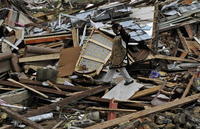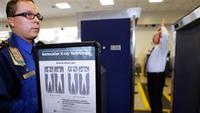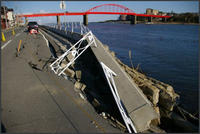-
Five Joplin survivors die of mysterious fungal infection
After being hit by a massive tornado that destroyed much of Joplin, Missouri, several residents suffered from a fungal infection that killed five people; following the 22 May twister that ravaged Joplin, many residents suffered from splinters, cuts, and other minor injuries that eventually resulted in a rare fungus infection
-
-
Illinois cracks down on "storm chasers"
In response to the series of severe storms and floods that struck Illinois, Governor Pat Quinn signed legislation to help protect homeowners as they rebuild; House Bill 3034 is aimed at protecting homeowners from “storm chasers,” contractors who take advantage of unsuspecting homeowners
-
-
Disasters take toll on PartnerRe’s profits
On Monday PartnerRe Ltd., the international reinsurer, announced that its second quarter earnings fell 35 percent as a result of the devastating natural disasters that struck around the world
-
-
USDA declares twenty disaster zones in California
On Monday the U.S. Department of Agriculture (USDA) designated twenty counties across California as natural disaster areas, qualifying residents for federal assistance; severe weather in these areas resulted in large losses to this season’s sweet cherry and wine grape crops
-
-
Improved engineering to protect structures on storm’s edge

In the wake of the horrendous tornadoes that delivered massive destruction to Alabama in April, University of Alabama engineers have analyzed building structures and design codes to recommend an approach to safer and stronger buildings going forward
-
-
How smartphones are fighting floods
A new smartphone app is helping the Army Corps of Engineers to strengthen its levees and fight floods in Kansas;filing reports is as simple as using a smartphone to take a picture, adding a note, and uploading the information to a database, which only takes a few seconds; this new system helps reduce the time it takes to gather critical information about levees by as much as thirty-six hours, giving engineers valuable additional time to detect and save a failing levee
-
-
U.S. General: troops unprepared for nuke risks in Japan
A U.S. general admitted that U.S. troops stationed in Japan did not have the proper training or equipment to handle radiation exposure in the days immediately following the nuclear crisis at the Fukushima Daiichi power plant caused by the 11 March earthquake and tsunami
-
-
Earthquakes: scientists will shake 5-story building in Japan
Landmark earthquake engineering tests this summer in Japan could open the door for earthquake-proofing technology applied to hospitals, nuclear power plants, and emergency-response facilities to be more common in the United States, and confirm the capabilities for the technology used in Japan and the rest of the world
-
-
Two Kiwi goldfish survive without food for more than four months

Workers returning to a downtown office in Christchurch, New Zealand, discover goldfish alive in their tank at the office; the goldfish have not been fed since the February floods forced the evacuation of the town; fish expert theorize that bacteria kept the water in the tank clean, and that the fish ate algae which grew on rocks in the tank
-
-
Full-body scanning for the shy

The Transportation and Security Administration will soon launch Full Body Scanning 2.0 at several New York area airports; the new software, known as Automated Target Recognition (ATR), will auto-detect items that could pose a potential threat that passengers might be carrying under their clothes, but the suspicous items will be shown against a generic outline of a person for all passengers
-
-
The economic costs of natural disasters
It appears that the verdict is still on out on the economic effects of natural disasters with researchers reaching diverging conclusions on the matter; New Zealand’s economy has actually grown 0.8 percent in the first quarter of this year, despite the 6.3 magnitude earthquake that rocked Christchurch, New Zealand in February; New Zealand may have escaped with little economic repercussions, but studies show that this is not always the case with natural disasters
-
-
Studying disasters in order to prepare for them
Disaster Research Center scientists study the world’s worst disasters in hopes of saving more lives in the future; one of the center’s experts says that disaster planning is constantly changing: “As we have a combination of new threats that face us — natural and technological — as we have changes in climate, as we have changes in population density, in where people are living, people are put at risk and new issues are created”
-
-
Japan halts shipments of radioactive beef
The Japanese government is coming under fire for only halting shipments of contaminated cattle now, four months after the 11 March earthquake and tsunami that led to the nuclear crisis at the Fukushima Daiichi atomic energy station; authorities recently discovered that 637 cattle had been fed hay contaminated with radioactive cesium and then shipped from farms in northern prefectures including Fukushima
-
-
Virginia powerplant holds nuke disaster simulation
On Tuesday, nuclear plant officials and emergency responders recently participated in an exercise to simulate an accident at the Surry atomic power plant in Virginia; Dominion Virginia Power, which operates the state’s four nuclear reactors, regularly holds exercises like these at the Surry plant, but following Japan’s nuclear disaster, the exercises have become even more important
-
-
Studying the Japan quake's impact on soil will improve building design

The 11 March quake that hit Japan weakened subsurface materials by as much as 70 percent; that nonlinear response from the top layer of the Earth’s crust affected how the movement of faults deep beneath the surface was delivered to buildings, bridges, and other structures; understanding how the soil responds to powerful earthquakes could be important to engineers and architects designing future buildings to withstand the level of acceleration measured in this quake
-
More headlines
The long view
Using Drone Swarms to Fight Forest Fires
Forest fires are becoming increasingly catastrophic across the world, accelerated by climate change. Researchers are using multiple swarms of drones to tackle natural disasters like forest fires.
How Climate Change Will Affect Conflict and U.S. Military Operations
“People talk about climate change as a threat multiplier,” said Karen Sudkamp, an associate director of the Infrastructure, Immigration, and Security Operations Program within the RAND Homeland Security Research Division. “But at what point do we need to start talking about the threat multiplier actually becoming a significant threat all its own?”
